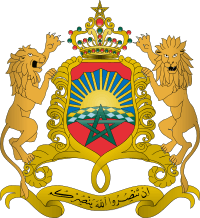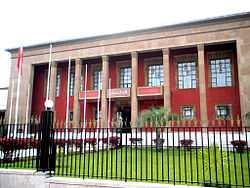Politics of Morocco
 |
| This article is part of a series on the politics and government of Morocco |
|
Monarchy |
|
Government
|
| Judiciary |
|
|
|
Politics portal |
Politics of Morocco take place in a framework of a parliamentary constitutional monarchy, whereby the Prime Minister of Morocco is the head of government, and of a multi-party system. Executive power is exercised by the government. Legislative power is vested in both the government and the two chambers of parliament, the Assembly of Representatives of Morocco and the Assembly of Councillors. The Moroccan Constitution provides for a monarchy with a Parliament and an independent judiciary.
On June 17, 2011 King Mohamed VI announced a series of reforms that would transform Morocco into a constitutional monarchy.[1][2]
Executive branch
| Office | Name | Party | Since |
|---|---|---|---|
| King | Mohammed VI | 23 July 1999 | |
| Prime Minister | Abdelillah Benkirane | Justice and Development Party | 29 November 2011 |
The constitution grants the king extensive powers; he is both the secular political leader and the "Commander of the Faithful" as a direct descendant of the Prophet Mohammed. He presides over the Council of Ministers; appoints the Prime Minister following legislative elections, and on recommendations from the latter, appoints the members of the government. While the constitution theoretically allows the king to terminate the tenure of any minister, and after consultation with the heads of the higher and lower Assemblies, to dissolve the Parliament, suspend the constitution, call for new elections, or rule by decree, the only time this happened was in 1965. The King is formally the chief of the military. Upon the death of his father Mohammed V, King Hassan II succeeded to the throne in 1961. He ruled Morocco for the next 38 years, until he died in 1999. His son, King Mohammed VI, assumed the throne in July 1999.
Following the March 1998 elections, a coalition government headed by opposition socialist leader Abderrahmane Youssoufi and composed largely of ministers drawn from opposition parties, was formed. Prime Minister Youssoufi's government is the first government drawn primarily from opposition parties in decades, and also represents the first opportunity for a coalition of socialist, left-of-center, and nationalist parties to be included in the government until October 2002. It was also the first time in the modern political history of the Arab world that the opposition assumed power following an election. The current government is headed by Abdelillah Benkirane.
Legislative branch

Since the constitutional reform of 1996, the bicameral legislature consists of two chambers. The Assembly of Representatives of Morocco (Majlis al-Nuwab/Assemblée des Répresentants) has 325 members elected for a five-year term, 295 elected in multi-seat constituencies and 30 in national lists consisting only of women. The Assembly of Councillors (Majlis al-Mustasharin) has 270 members, elected for a nine-year term, elected by local councils (162 seats), professional chambers (91 seats) and wage-earners (27 seats). The Parliament's powers, though limited, were expanded under the 1992 and 1996 constitutional revisions and include budgetary matters, approving bills, questioning ministers, and establishing ad hoc commissions of inquiry to investigate the government's actions. The lower chamber of Parliament may dissolve the government through a vote of no confidence.
Political parties and elections
On November 26, 2011 initial results of parliamentary elections were released. The moderate Islamist party, the Justice and Development Party (PJD), was projected to win the largest number of seats. However, the electoral rules were structured such that no political party could ever win more than 20 percent of the seats in the parliament.[3] The full results of the previous election appear as follows:
| Party | Votes | Votes % | Total seats | Seats % | Seat change | Const. seats | List seats | |
| Justice and Development Party (PJD) | 1,080,914 | 22.8 | 107 | 27.1 | 83 | 24 | ||
| Istiqlal Party | 562,720 | 11.9 | 60 | 15.2 | 47 | 13 | ||
| National Rally of Independents (RNI) | 537,552 | 11.3 | 52 | 13.2 | 40 | 12 | ||
| Authenticity and Modernity Party (PAM) | 524,386 | 11.1 | 47 | 11.9 | 35 | 12 | ||
| Socialist Union of Popular Forces (USFP) | 408,108 | 8.6 | 39 | 9.9 | 30 | 9 | ||
| Popular Movement (MP) | 354,468 | 7.5 | 32 | 8.1 | 24 | 8 | ||
| Constitutional Union (UC) | 275,137 | 5.8 | 23 | 5.8 | 17 | 6 | ||
| Party of Progress and Socialism (PPS) | 269,336 | 5.7 | 18 | 4.6 | 12 | 6 | ||
| Labour party (PT) | 107,399 | 2.3 | 4 | 1 | 4 | 0 | ||
| Environment and Development Party (PED) | 109,335 | 2.3 | 2 | 0.5 | 2 | 0 | ||
| Democratic and Social Movement (MDS) | 81,324 | 1.7 | 2 | 0.5 | 2 | 0 | ||
| Party of Renewal and Equity | X | X | 2 | 0.5 | 2 | 0 | ||
| Democratic Oath Party (SD) | X | X | 2 | 0.5 | 2 | 0 | ||
| Front of Democratic Forces | 135,161 | 2.8 | 1 | 0.3 | 1 | 0 | ||
| Green Left Party | 33,841 | 0.7 | 1 | 0.3 | 1 | 0 | ||
| Action Party (PA) | 14,916 | 0.3 | 1 | 0.3 | 1 | 0 | ||
| Union and Democracy Party (PUD) | X | X | 1 | 0.3 | 1 | 0 | ||
| Party of Liberty and Social Justice (PLJS) | X | X | 1 | 0.3 | 1 | 0 | ||
| Socialist Party (PS) | X | X | 0 | 0 | 0 | 0 | ||
| Moroccan Union for Democracy (UMD) | X | X | 0 | 0 | 0 | 0 | ||
| Citizens' Forces (PFC) | X | X | 0 | 0 | 0 | 0 | ||
| Party of Renaissance and Virtue (PRV) | X | X | 0 | 0 | 0 | 0 | ||
| National Congress Party (PCNI) | X | X | 0 | 0 | 0 | 0 | ||
| Moroccan Liberal Party (PLM) | X | X | 0 | 0 | 0 | 0 | ||
| Social Centre Party (PCS) | X | X | 0 | 0 | 0 | 0 | ||
| Reform and Development Party (PRD) | X | X | 0 | 0 | 0 | 0 | ||
| National Democratic Party | X | X | 0 | 0 | 0 | 0 | ||
| Party of Hope (PE) | X | X | 0 | 0 | 0 | 0 | ||
| Democratic Society Party (PSD) | X | X | 0 | 0 | 0 | 0 | ||
| Democratic Independence Party (PDI) | X | X | 0 | 0 | 0 | 0 | ||
| Independents | X | X | 0 | 0 | 0 | 0 | ||
| Total valid votes | 4,745,453 | 77.7 | 395 | 100% | 305 | 90 | ||
| Invalid votes | 1,361,511 | 22.3 | — | — | — | — | — | |
| Total votes cast (turnout 45.4%) | 6,106,964 | 100.0 | — | — | — | — | — |
Source: Moroccan government.[4][5]
Judicial branch
The highest court in the judicial structure is the Supreme Court, whose judges are appointed by the King. The Youssoufi government continued to implement a reform program to develop greater judicial independence and impartiality. Morocco is divided into 16 administrative regions; the regions are administered by the Walis and governors appointed by the King.
Administrative divisions
As part of a 1997 decentralization/regionalization law passed by the legislature 16 new regions (provided below) were created. It is the primary administrative division of Morocco : Chaouia-Ourdigha, Doukkala-Abda, Fes-Boulmane, Gharb-Chrarda-Beni Hssen, Greater Casablanca, Guelmim-Es Smara, Laayoune-Boujdour-Sakia El Hamra, Marrakech-Tensift-El Haouz, Meknes-Tafilalet, Oriental, Oued Eddahab-Lagouira, Rabat-Sale-Zemmour-Zaer, Souss-Massa-Drâa, Tadla-Azilal, Tangier-Tetouan, Taza-Al Hoceima-Taounate
Morocco is divided also into 37 provinces and 2 wilayas*: Agadir, Al Hoceima, Azilal, Beni Mellal, Ben Slimane, Boulemane, Casablanca*, Chaouen, El Jadida, El Kelaa des Sraghna, Er Rachidia, Essaouira, Fes, Figuig, Guelmim, Ifrane, Kenitra, Khemisset, Khenifra, Khouribga, Laayoune, Larache, Marrakech, Meknes, Nador, Ouarzazate, Oujda, Rabat-Sale*, Safi, Settat, Sidi Kacem, Tangier, Tan-Tan, Taounate, Taroudannt, Tata, Taza, Tetouan, Tiznit; three additional provinces of Ad Dakhla (Oued Eddahab), Boujdour, and Es Smara as well as parts of Tan-Tan and Laayoune fall within Moroccan-claimed Western Sahara
International organization affiliations
ABEDA, ACCT (associate), AfDB, AFESD, AL, AMF, AMU, EBRD, ECA, FAO, G-77, IAEA, IBRD, ICAO, ICCt, ICFTU, ICRM, IDA, IDB, IFAD, IFC, IFRCS, IHO (pending member), ILO, IMF, IMO, Intelsat, Interpol, IOC, IOM, ISO, ITU, NAM, OAS (observer), OIC, OPCW, OSCE (partner), UN, UNCTAD, UNESCO, UNHCR, UNIDO, UPU, WCO, WHO, WIPO, WMO, WToO, WTrO
References
- ↑ http://news.yahoo.com/s/ap/20110617/ap_on_re_mi_ea/ml_morocco_king
- ↑ http://www.irishtimes.com/newspaper/breaking/2011/0702/breaking8.html
- ↑ Middle East Online, "Moroccan Elections: A Barometer of Reform?" November 27, 2011 http://www.middle-east-online.com/english/?id=49230
- ↑ "Résultats définitifs des élections législatives du 25 novembre". Moroccan national portal site. Retrieved 28 November 2011.
- ↑ http://psephos.adam-carr.net/countries/m/morocco/morocco2011.txt
External links
- Government at the official portal of Morocco
- Portal with a comprehensive list of the Public Institutions and the Public Officials of Morocco
- Morocco list at the CIA Chiefs of State and Cabinet Members, March 17, 2011
- Morocco Government at DMOZ
| ||||||||||||||